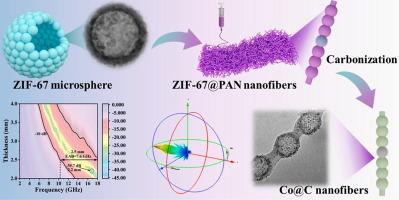Sugar-gourd-like Co@carbon nanofibers for ultralightweight and outstanding electromagnetic wave absorber
IF 14.9
1区 化学
Q1 Energy
引用次数: 0
Abstract
To address increasing electromagnetic interference and pollution problems, this study proposes a component regulation strategy. Hollow magnetic microspheres derived from metal-organic frameworks (MOFs) were incorporated into carbon fibers (Co@CNFs) through electrospinning technology, forming a sugar-gourd-like heterostructure. This structure promotes the synergy between dielectric and magnetic losses. The full utilization of multi-component synergy and the well-designed heterogeneous interfaces enhances interfacial polarization and optimizes the balance between impedance and high loss. The hollow structure of magnetic microspheres facilitates multiple scattering of electromagnetic waves (EMW). Additionally, the change of heat treatment temperature offers a viable method to adjust the dielectric properties of composites. The results indicate that the Co@CNFs exhibit outstanding EMW attenuation capability, even at an ultralow filler loading of 3 wt%, achieving a reflection loss of −39.7 dB and an effective absorption bandwidth of 7.6 GHz. This study demonstrates the effectiveness of component regulation and offers a viable approach for lightweight, high-performance EMW absorption materials.

糖葫芦状Co@carbon纳米纤维,重量超轻,能吸收电磁波
为了解决日益严重的电磁干扰和污染问题,本研究提出了一种组件调节策略。通过静电纺丝技术将金属有机骨架(MOFs)制成的空心磁性微球掺入碳纤维(Co@CNFs)中,形成糖葫芦状异质结构。这种结构促进了介电损耗和磁损耗之间的协同作用。充分利用多组分协同和精心设计的异质接口,增强了界面极化,优化了阻抗和高损耗之间的平衡。磁性微球的中空结构有利于电磁波的多次散射。另外,热处理温度的变化为调整复合材料的介电性能提供了可行的方法。结果表明,Co@CNFs具有出色的EMW衰减能力,即使在3 wt%的超低填料负载下,反射损耗为- 39.7 dB,有效吸收带宽为7.6 GHz。该研究证明了组件调节的有效性,并为轻质、高性能EMW吸收材料提供了可行的方法。
本文章由计算机程序翻译,如有差异,请以英文原文为准。
求助全文
约1分钟内获得全文
求助全文
来源期刊

Journal of Energy Chemistry
CHEMISTRY, APPLIED-CHEMISTRY, PHYSICAL
CiteScore
19.10
自引率
8.40%
发文量
3631
审稿时长
15 days
期刊介绍:
The Journal of Energy Chemistry, the official publication of Science Press and the Dalian Institute of Chemical Physics, Chinese Academy of Sciences, serves as a platform for reporting creative research and innovative applications in energy chemistry. It mainly reports on creative researches and innovative applications of chemical conversions of fossil energy, carbon dioxide, electrochemical energy and hydrogen energy, as well as the conversions of biomass and solar energy related with chemical issues to promote academic exchanges in the field of energy chemistry and to accelerate the exploration, research and development of energy science and technologies.
This journal focuses on original research papers covering various topics within energy chemistry worldwide, including:
Optimized utilization of fossil energy
Hydrogen energy
Conversion and storage of electrochemical energy
Capture, storage, and chemical conversion of carbon dioxide
Materials and nanotechnologies for energy conversion and storage
Chemistry in biomass conversion
Chemistry in the utilization of solar energy
 求助内容:
求助内容: 应助结果提醒方式:
应助结果提醒方式:


